Litchi, Lychee
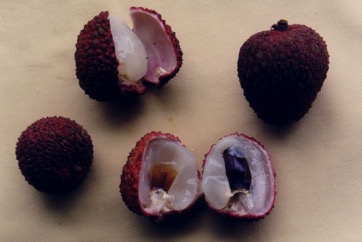
A subtropical plant. It is native to Asia from China to Malaysia. It suits the tropical highlands. It grows satisfactorily in the humid equatorial coastal areas but does not fruit. For fruiting it needs to be at a higher altitude or latitude because it has a cold temperature chilling requirement. Most varieties need between 100 and 200 hours of standard chilling (0° and 7°C). It needs a deep moist soil and freedom from frost. Trees can stand temperatures down to -2°C when mature. Temperatures below 5°C at flowering upset normal flower opening. Cool dry climates are important. Temperatures between 20-38°C suit good fruiting. Although litchi will grow on a range of soils, well drained soils are best. A pH between 5.5 and 7.5 is suitable. In Brisbane Botanical Gardens. In XTBG Yunnan. It suits hardiness zones 10-11.
Also known as:
Alupag, Buah lengkeng, Cay vai, Kelengkang, Klenkeng, Kou len, Kulaen, Kyetmauk, Kyet-mouk, Laichi, Laici, Lam yai, Lechu, Letsias, Lichi, Lichu, Lin chi, Linchee, Lisu, Litchee, Litisia, Litsi, Litsiyu, Lizhi, Mamoncillo chino, Muolhoi, Ngeew, Nkui chi, Reishi, Soh-manir, Tayok-zi, Tu hu, Vai chua, Vai, Vaitheifeimung, Wa-mayar, Yaulizi
Synonyms
- Dimocarpus litchi Lour.
- Nephelium litchi Cambess nom illeg
- Euphoria didyma Blanco
- for subsp philippinensis Litchi philippinensis Radlk.
- Litchi sinensis J. Gmelin
Edible Portion
- Fruit, Aril
Where does Litchi grow?
Found in: Africa, Andamans, Asia, Australia, Bangladesh, Brazil, Cambodia, Cameroon, Central Africa, Central America, China, Cook Islands, Costa Rica, Cuba, East Africa, East Timor, Fiji, Hawaii, Himalayas, Honduras, India, Indochina, Indonesia, Israel, Jamaica, Laos, Madagascar, Malawi, Malaysia, Marquesas, Mauritius, Mexico, Mozambique, Myanmar, Nauru, Nepal, New Caledonia, New Zealand, North America, Northeastern India, Pacific, Pakistan, Papua New Guinea, PNG, Philippines, Reunion, SE Asia, Singapore, Slovenia, South Africa, Southern Africa, South America, Suriname, Taiwan, Thailand, Timor-Leste, Trinidad, United States, Vanuatu, Vietnam, West Indies, Zimbabwe
Notes: There is only one Litchi species.
Status: It is an important fruit in Asia and is exported. It has been introduced into Papua New Guinea and trees grow well but fruiting is rare probably because trees should be at mid altitude zones.
Growing Litchi, Lychee
Cultivation: Trees are mostly grown from seed but they do not breed true and are slow to produce. Trees can be propagated by aerial layering, grafting or cuttings. Air layering is best. Seeds do not store well (4-5 days), so fresh seed must be sown. Air layers on mature branches in the warmer season are best. Branches of 2 to 2.5 cm across with 45 cm of shoot are suitable for air layers. A spacing between trees of 10-12 m is suitable. Good soil preparation prior to planting enables good early growth. Organic matter dug in over 1 metre square and 30 cm deep 3 months before planting is good. A stick for support of the young plant and shelter are needed at planting. A pH of 5.5 to 6.0 is required. Because it is shallow rooting, cultivation should be avoided and mulching practised. Small amounts of fertiliser added often is the appropriate method. Lychee trees have a high water consumption. Only limited tree training is required. Often no general pruning is required. Plants need adequate water but not waterlogged soil.
Edible Uses: The fleshy pulp around the seeds is eaten. They are eaten fresh, preserved or dried. They are pickled, canned, used in jams. sauces, fruit salads, ice cream and made into wine. Dried tea leaves are soaked in lychee juice then dried again to impart a lychee flavour.
Production: Seedling trees take 8-12 years to start fruiting. Vegetatively propagated trees bear in 4-6 years. Fruiting is normally seasonal. It takes 140 days from flowering to fruit maturity. Fruit need to be harvested ripe from the tree. The normal harvesting method is to remove the fruit with a few cm of the stem still attached. Early fruit set is affected by vegetative growth at flowering. Insects (bees) are important for fruit set. Wind breaks are essential because wind at flowering can reduce fruit set. A 20 year old tree can produce 5,000 fruit or 100 kg.
Nutrition Info
per 100g edible portion| Edible Part | Energy (kcal) | Protein (g) | Iron (mg) | Vitamin A (ug) | Vitamin c (mg) | Zinc (mg) | % Water |
|---|---|---|---|---|---|---|---|
| Fruit - raw | 68 | 1.1 | 0.5 | 0 | 49 | 0.1 | 80.6 |
Litchi, Lychee Photos

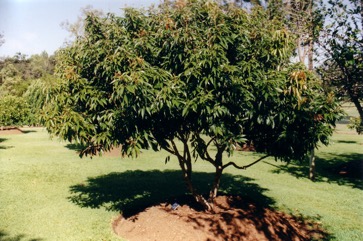
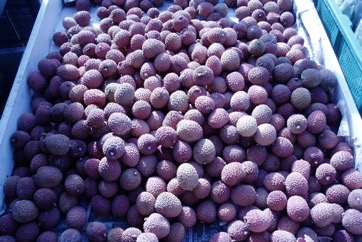
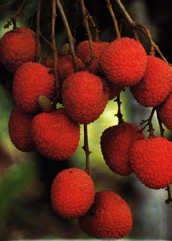
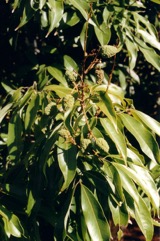
References
AAK, 1980, Bertanam Pohon Buah-buahan. Penerbitan Yayasan Kanisius, Jogyakarta. p 70
Alegado, A. M. & De Guzman, R. B., 2014, Indigenous food crops of the Aetas tribe in the Philippines and their traditional methods of food preparation. in Promotion of Underutilized Indigenous Food Resources for Food Security and Nutrition in Asia and Pacific. FAO. Bangkok p 160 (As Euphoria didyma)
Alexander, D.M., Scholefield, P.B., Frodsham, A., 1982, Some tree fruits for tropical Australia. CSIRO, Australia. p 31
Ali, A. M. S., 2005, Homegardens in Smallholder Farming Systems: Examples from Bangladesh. Human Ecology, Vol. 33, No. 2 pp. 245-270 (As Nephelium litchi)
Ambasta, S.P. (Ed.), 2000, The Useful Plants of India. CSIR India. p 332
Anderson, E. F., 1993, Plants and people of the Golden Triangle. Dioscorides Press. p 214
Arora, R. K., 2014, Diversity in Underutilized Plant Species - An Asia-Pacific Perspective. Bioversity International. p 74
Barwick, M., 2004, Tropical and Subtropical Trees. A Worldwide Encyclopedic Guide. Thames and Hudson p 250
Bianchini, F., Corbetta, F., and Pistoia, M., 1975, Fruits of the Earth. Cassell. p 172
Bodkin, F., 1991, Encyclopedia Botanica. Cornstalk publishing, p 645
Burkill, H. M., 1985, The useful plants of west tropical Africa, Vol. 5. Kew. (As Nephelium litchi)
Burkill, I.H., 1966, A Dictionary of the Economic Products of the Malay Peninsula. Ministry of Agriculture and Cooperatives, Kuala Lumpur, Malaysia. Vol 2 (I-Z) p 1572 (As Nephelium litchi)
Chandrashekara, U. M., 2009, Tree species yielding edible fruit in the coffee-based homegardens of Kerala, India: their diversity, uses and management. Food Sec. 1:361-370 (As Nephelium litchi)
Cheifetz, A., (ed), 1999, 500 popular vegetables, herbs, fruits and nuts for Australian Gardeners. Random House p 198
Coronel, R.E., 1982, Fruit Collections in the Philippines. IBPGR Newsletter p 7 (As Litchi sinensis)
Cull, B.W., 1995, Fruit Growing in Warm Climates. Reed. p 89
Cundall, P., (ed.), 2004, Gardening Australia: flora: the gardener's bible. ABC Books. p 828
Darley, J.J., 1993, Know and Enjoy Tropical Fruit. P & S Publishers. p 61
Das, T. & Das, A. K., 2005, Inventorying plant biodiversity in homegardens: A case study in Barak Valley, Assam, North East India. CURRENT SCIENCE, VOL. 89, NO. 1, 10 JULY 2005
Engel, D.H., & Phummai, S., 2000, A Field Guide to Tropical Plants of Asia. Timber Press. p 60
Etherington, K., & Imwold, D., (Eds), 2001, Botanica's Trees & Shrubs. The illustrated A-Z of over 8500 trees and shrubs. Random House, Australia. p 441
Facciola, S., 1998, Cornucopia 2: a Source Book of Edible Plants. Kampong Publications, p 224
Flora of Pakistan. www.eFloras.org
French, B.R., 1986, Food Plants of Papua New Guinea, A Compendium. Asia Pacific Science Foundation p 280
Gardner, S., et al, 2000, A Field Guide to Forest Trees of Northern Thailand, Kobfai Publishing Project. p 135
Hedrick, U.P., 1919, (Ed.), Sturtevant's edible plants of the world. p 303 (As Euphoria informis)
Hedrick, U.P., 1919, (Ed.), Sturtevant's edible plants of the world. p 435 (As Nephelium litchi)
Heywood, V.H., Brummitt, R.K., Culham, A., and Seberg, O., 2007, Flowering Plant Families of the World. Royal Botanical Gardens, Kew. p 294
Hibbert, M., 2002, The Aussie Plant Finder 2002, Florilegium. p 185
http://www.botanic-gardens-ljubljana.com/en/plants
Hu, Shiu-ying, 2005, Food Plants of China. The Chinese University Press. p 525
INFOODS:FAO/INFOODS Databases
Jardin, C., 1970, List of Foods Used In Africa, FAO Nutrition Information Document Series No 2.p 145
Jeeva, S., 2009, Horticultural potential of wild edible fruits used by the Khasi tribes of Meghalaya. Journal or Horticulture and Forestry Vol. 1(9) pp. 182-192
Jin, Chen et al, 1999, Ethnobotanical studies on Wild Edible Fruits in Southern Yunnan: Folk Names: Nutritional Value and Uses. Economic Botany 53(1) pp 2-14
John, L., & Stevenson, V., 1979, The Complete Book of Fruit. Angus & Robertson p 177
Khan, D. & Shaukat, S.S., 2006, The Fruits of Pakistan: Diversity, Distribution, Trends of Production and Use. Int. J. Biol. Biotech., 3(3):463-499
Khanal, R., et al, 2014, Documenting abundance and use of underutilized plant species in the mid hill region of Nepal. ECOPRINT 21: 63-71, 2014
Kiple, K.F. & Ornelas, K.C., (eds), 2000, The Cambridge World History of Food. CUP p 1802
Lalfakzuala, R., 2007, Ethnobotanical usages of plants in western Mizoram. Indian Journal of Traditional Knowledge. Vol 6(3) pp 480-493
Lazarides, M. & Hince, B., 1993, Handbook of Economic Plants of Australia, CSIRO. p 149
Lembaga Biologi Nasional, 1977, Buah-Buahan, Balai Pustaka, Jakarta. p 82
Llamas, K.A., 2003, Tropical Flowering Plants. Timber Press. p 343
Lorenzi, H., Bacher, L., Lacerda, M. & Sartori, S., 2006, Brazilian Fruits & Cultivated Exotics. Sao Paulo, Instituto Plantarum de Estuados da Flora Ltda. p 608
Lyle, S., 2006, Discovering fruit and nuts. Land Links. p 260
Macmillan, H.F. (Revised Barlow, H.S., et al) 1991, Tropical Planting and Gardening. Sixth edition. Malayan Nature Society. Kuala Lumpur. p 282
Manandhar, N.P., 2002, Plants and People of Nepal. Timber Press. Portland, Oregon. p 295
Martin, F. W., et al, 1987, Perennial Edible Fruits of the Tropics. USDA Handbook 642 p 57
Martin, M.A., 1971, Introduction L'Ethnobotanique du Cambodge. Centre National de la Recherche Scientifique. Paris.
Massal, E. and Barrau, J., 1973, Food Plants of the South Sea Islands. SPC Technical Paper No 94. Noumea, New Caledonia. p 42
McMakin, P.D., 2000, Flowering Plants of Thailand. A Field Guide. White Lotus. p 109 (As Nephelium litchi)
Medhi, P. & Borthakur, S. K., 2012, Phytoresources from North Cachur Hills of Assam -3: Edible plants sold at Hflong market. Indian Journal of Natural Products and Resources. 3(1) pp 84-109
Miguel, E., et al, 1989, A checklist of the cultivated plants of Cuba. Kulturpflanze 37. 1989, 211-357
Morton, J. F., 1987, Fruits of Warm Climates. Wipf & Stock Publishers p 249
Murtem, G. & Chaudhrey, P., 2016, An ethnobotanical note on wild edible plants of Upper Eastern Himalaya, India. Brazilian Journal of Biological Sciences, 2016, v. 3, no. 5, p. 63-81.
Owen, S., 1993, Indonesian Food and Cookery, INDIRA reprints. p 67
Peekel, P.G., 1984, (Translation E.E.Henty), Flora of the Bismarck Archipelago for Naturalists, Division of Botany, Lae, PNG. p 341, 340
Phon, P., 2000, Plants used in Cambodia. © Pauline Dy Phon, Phnom Penh, Cambodia. p 404
PROSEA (Plant Resources of South East Asia) handbook, Volume 2, 1991, Edible fruits and nut. p 191
Purseglove, J.W., 1968, Tropical Crops Dicotyledons, Longmans. p 642
Rashid, H. E., 1977, Geography of Bangladesh. Westview. p 341 (As Nephelium litchi)
Recher, P, 2001, Fruit Spirit Botanical Gardens Plant Index. www.nrg.com.au/~recher/ seedlist.html p 2
Ruiters-Welcome, A. K., 2019, Food plants of southern Africa. Ph.D. thesis. Univ. of Johannesburg p 100
Sawian, J. T., et al, 2007, Wild edible plants of Meghalaya, North-east India. Natural Product Radiance Vol. 6(5): p 418
Segura, S., et al, 2018, The edible fruit species in Mexico. Genet Resour Crop Evol (2018) 65:1767–1793
Sharma, B.B., 2005, Growing fruits and vegetables. Publications Division. Ministry of Information and broadcasting. India. p 80
Smith, K., 1998. Growing Uncommon Fruits and Vegetables. New Holland. p 85
Smith, P.M., 1979, Litchi, in Simmonds, N.W., (ed), Crop Plant Evolution. Longmans. London. p 321
Soepadmo, E. and Wong, K. M. and Saw, L. G., 1996, Tree Flora of Sabah and Sarawak. Forestry Malaysia. Volume Two. p 326
Solomon, C., 2001, Encyclopedia of Asian Food. New Holland. p 224
Staples, G.W. and Herbst, D.R., 2005, A tropical Garden Flora. Bishop Museum Press, Honolulu, Hawaii. p 515 (Drawing)
Sukarya, D. G., (Ed.) 2013, 3,500 Plant Species of the Botanic Gardens of Indonesia. LIPI p 359
Tankard, G., 1990, Tropical fruit. An Australian Guide to Growing and using exotic fruit. Viking p 64
Tate, D., 1999, Tropical Fruit. Archipelago Press. Singapore. p 66
Upreti, K., et al, 2010, Diversity and Distribution of Wild Edible Fruit Plants of Uttarakhand. Bioversity Potentials of the Himalaya. p 174
USDA, ARS, National Genetic Resources Program. Germplasm Resources Information Network - (GRIN). [Online Database] National Germplasm Resources Laboratory, Beltsville, Maryland. Available: www.ars-grin.gov/cgi-bin/npgs/html/econ.pl (10 April 2000)
Valder, P., 1999, The Garden Plants of China. Florilegium. p 300
van Wyk, B., 2005, Food Plants of the World. An illustrated guide. Timber press. p 230
Vivien, J., & Faure, J.J., 1996, Fruitiers Sauvages d'Afrique. Especes du Cameroun. CTA p 311
Walter, A. & Lebot, V., 2007, Gardens of Oceania. ACIAR Monograph No. 122. p 159
Williamson, J., 2005, Useful Plants of Malawi. 3rd. Edition. Mdadzi Book Trust. p 154
World Checklist of Useful Plant Species 2020. Royal Botanic Gardens, Kew
www.worldagroforestrycentre.org/treedb/
Zawiah, N. & Othaman, H., 2012, 99 Spesies Buah di FRIM. Institut Penyelidikan Perhutanan Malaysia. p 136